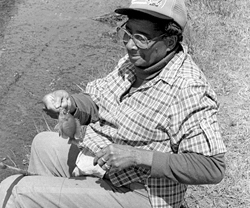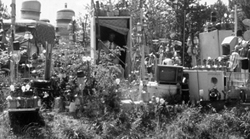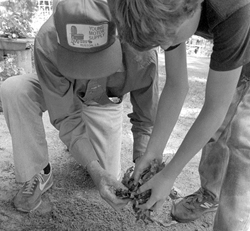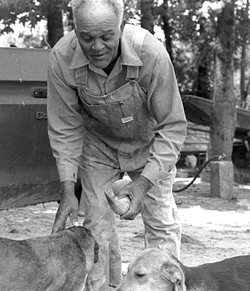
Fishing, Hunting, And Trapping
One time I gigged a 132 pound gar...and I couldn't handle it. I was in a little paddle boat, and I had some neighbors, Archie Wilhite and Charlie Barkley. I came out and got them to help me. I had him tied to a swinging oak limb in the backwater. He'd go this way and that way...When I got a hold of my gig, he come up to the top, and Barkley gigged him with his gig and wrestled with him for a while round there and rolled him over in my boat and brought him to the bank...He was big as a man...We went down there and got him with a wagon and brought him to the house and dressed him out, got what we wanted, and give all the neighbors some...We fried that; you can't cut it where it doesn't have a bone in it, a tall. They got a rib cage there and they got a wide strip by the stomach and then they got a wide part on the backbone -- what I call the tenderloin --not a bone in that; you cut it off the backbone, cut the ribs off of it, and cut it straight crossways in little thin strips. You talk about something good to eat -- that is! -- Howard Henry
One night we went [coon-hunting] and they [the dogs] treed, and we made a fire and lay down and went to sleep, and a wolf come and started dragging my daddy off [by the britches leg]. He dragged him off to this tree over there; then he woke up and said "Eeee, get 'em, dogs." Them dogs was running trying to catch that wolf. That wolf got in the creek; he swim all the way down that creek. He was skimming that water! He looked like that dog; he was brown and got a big bushy tail like a fox. -- Hugh Lee Cooper

Given the numerous lakes and creeks and the dense forests, perhaps the most popular pastimes for many in north central Louisiana are fishing and hunting and the telling of their resulting stories and tall tales. These sports may be social events in which several family members or neighbors take part, or they may be solitary endeavors in which the individual matches wit with nature. Many people in the area are practically obsessed with these sports, hailing back to times when the settlers relied on them for food. As Annie Rene Harris put it: "I've got one son, all he ever does is look cross-eyed at the creek. Everytime, he can come back with a foot-tub of fish."
Fishing remains a popular traditional sport of all economic classes; the gear changes with the finances and the intent. Blacks and whites alike (often in whole families) converge on nearby lakes, rivers, or creeks to bank fish using simple cane poles with catalpa worms for bait. Many others with large bass motor boats and rods and reels fish area lakes in the popular bass tournaments.
Some commercial fishing is still done in the area with hoop, trammel, and gill nets. Usually, as in the case of Howard Henry and his son W.T., fishing income is only a supplement to another job. A few fishermen like the Henrys continue to make much of their own equipment such as traditional hoop nets and boat paddles. Their hoop nets today usually have a fiberglass or rubber hose hoop instead of the traditional white-oak hoop; however, the form and the techniques for weaving the nets are the same.
Boatbuilding, although becoming rare, may also be found with the most common traditional form being the "little john boat," an approximately twelve-foot long skiff made of cypress milled lumber sealed with tar. Boat builders such as Cecil Tiddwell, a retired carpenter from Wilhite, built boats for himself and community members such as Howard Henry. In Mr. Henry's father's generation, most people built their own boats rather than having a specialist build them.
Trapping and hunting which sustained the first settlers in the region are still practiced although they no longer provide a sole livelihood. Many other retired farmers such as Clonie Otwell and some younger people continue to trap coons, mink, nutria, bobcats, and other small game for their hides. A few hide traders such as Roy Bayles will purchase the hides for marketing. Old commercial steel traps are the preferred method of trapping, and the traditional methods of tracking the animals and setting the traps are still practiced (Figure 9).
More popular, hunting has the most avid followers. Crafts associated with the various types of hunting are also practiced in the region. However, the traditional decoys prevalent in central Louisiana do not seem to have had wide use in the north central area. The few decorative decoy carvers in the area have learned carving from books and workshops. According to area hunters, decoys were not necessary for hunting in the earlier days when ducks and covers were plentiful.
A few good carvers like Truett Moore and Homer Eaves do, however, make gunstocks, usually to replace a commercial one. Other paraphernalia such as turkey callers made by Lonnie Gray and duck callers are reviving in popularity. Still used and made today, the hunting horn or blowing horn for calling dogs is an especially important piece of hunting equipment which must be carefully burned out, scraped, and sanded to produce a good sound.
One of the most important elements of the hunt in the area is the hunting dog, which has been bred for specific game since the days of the early settlers. Different breeds of hounds, such blue tick, red bone, and black and tan, are used to hunt deer, foxes, and coon. A variety of bird dogs, including retriever, setter, pointer, and spaniel breeds are highly valued for hunting duck, quail, and dove. Hunting small game, sometimes termed "varmits" such as squirrel, possum, rabbit, or armadillo, usually requires a "fice" or "feist" dog, a mixed breed, which is bred and trained to run or tree game. While their size and color can vary, typically, fice are smaller than these other breeds, averaging 12-24 inches tall, and may be white with black spots (or maybe brown spots), similar to a Jack Russell terrier. Probably the most highly regarded today is the Catahoula cur hog dog, a breed developed especially in Louisiana to round up and pen free-ranging wild hogs. Today, the Catahoula cur (sometimes called hound today) is also used for herding, hunting (especially deer), and guarding as well.
Verbal Arts And Oral History
I want to tell you a story about some cold weather we had up there one time -- about two years ago it got real cold. A fellow had a pond right close to his house there and late that evening -- it was a real cold day -- a flock of geese come over and stopped in his pond to spend the night, and it got real cold that night and everything froze over, and this fellow decided he would go down there the next morning and shoot a few of them geese. He got down there, and their feet was froze in that pond and they couldn't fly. They got to flapping their wings, and he got to shooting at them, and they finally got to flapping their wings together and they flew off with his pond. -- Lonnie Gray
Although tall tales such as the above are not told as frequently as they once were, storytellers such as Lonnie Gray, from Bernice, still enjoy telling them. In addition to hunting and fishing narratives, jokes and tall tales, other traditional verbal arts are also common in the area. Talking and visiting are especially valued among rural neighbors and families and take place in the home and community centers such as the general store and church gatherings. Gossip and personal anecdotes are the most common sociolinguistic genres which occur in the conversation. Many older folks especially enjoy reminiscencing about their early days and traditional lifestyles. Many are also aware that their memories are important as oral history. Artist DeCinter Farley has begun painting her memories in an attempt to further preserve this history. Her paintings then become visual cues which evoke personal narratives such as the following:
"On Sundays when church was over, we'd all go down into the pasture to play. Somebody would get on a stump and go to preaching. The rest of us would sing and one of us would start baptizing, just like the preacher, there in the bitterweeds."

Narratives such as this round out local history by providing social information on children's play and the importance of religion. Mrs. Farley's memories of other traditional farm activities such as hog-killings, syrup-making, and cotton-picking along with others' accounts of folk traditions including quilting bees, log rollings, house dances and play party games provide details of work and play in daily life during earlier days in the region. These accounts and the stories of local characters, legends, and events serve to complete the historical picture of the region.
In addition to farming oral history and stories, there is also a wealth of verbal lore surrounding the petroleum and timber industries, which are quite important to north central Louisiana. In particular, drilling and logging were occupations which were learned and passed on in a "hands on" folk process. Partly because of the difficulties and excitement inherent in them, these occupations are especially rich in their own esoteric verbal lore and jargon which is passed on within the occupation. Ex-loggers like Merritt Robertson, of Litro, have stories ranging from handling ornery mules to felling giant trees; oil men like Merritt Robertson, of Luna, now retired, can explain the basic oilman's vocabulary.
The language in which these stories are told still exhibits many non-standard constructions ("used to could," "ain't never,") and pronunciations (middle English for it-- "hit," and a distinctive drawl). The regional dialect is still predominantly southern with basic difference between black and white speech. Vocabulary seems fairly standard to southern speech although a few unfamiliar usages were observed; for example, the verb to follow is used in black communities to mean to accompany or to go with. A most interesting word is also used in the black communities to refer to old fashioned, traditional practices or beliefs -- old folksism or also called old folkyism. It, no doubt, stems from the same root as folklore, and could perhaps be a mispronunciation of folklorism; however, it seems unlikely that this would be the case since the users of the word remembered the word as one they heard all their lives. At any rate, there does seem to be a correlation between the academic use of the word folklore and the folk term old folksism, a coincidence which merits further linguistic research.




